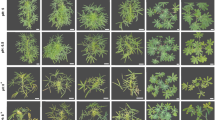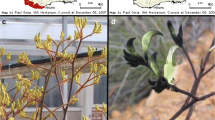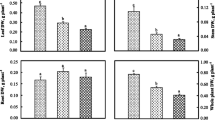Abstract
Aims
Previous studies have shown that pH, rather than calcium (Ca), is the main reason why some Lupinus species are sensitive to nutrient solutions mimicking calcareous soils; however, a hydroponic system is quite different from soil systems, and plants may respond differently to these two growing conditions. Thus, studies with Lupinus species grown in calcareous soils are needed.
Methods
Two calcicole and two calcifuge species were grown in river sand with different Ca forms and amounts, pH levels, and [bicarbonate (HCO3−)] (HCO3− concentration, which is produced by calcium carbonate (CaCO3)). Leaf symptoms, leaf area, gas exchange, biomass, and root morphology were recorded; whole leaf and root nutrient concentrations were analysed.
Results
We observed leaf chlorosis of the youngest leaves under high pH (adjusted by KOH) and high pH + high Ca (representing high [HCO3−], high pH and high Ca) treatments for all Lupinus species. However, after 2 weeks, leaf chlorosis of all Lupinus species under high pH started to disappear, with calcicole species fully, and calcifuge species only partly recovering. Leaf chlorosis symptoms of calcicole species under high pH + high Ca partly disappeared as well, while those of calcifuge species did not disappear at all.
Conclusions
High pH (resulting from either KOH or HCO3−) inhibited root growth, and subsequently uptake of some nutrients and shoot growth of Lupinus species. However, the strong buffering capacity of HCO3− is the key factor determining if Lupinus species can survive in calcareous soils. Among all studied Lupinus species, L. pilosus was the most tolerant to high [HCO3−] and/or high pH, followed by L. cosentinii and L. angustifolius, while L. hispanicus was the most sensitive.







Similar content being viewed by others
References
Abd-Alla MH (1999) Nodulation and nitrogen fixation of Lupinus species with Bradyrhizobium (lupin) strains in iron-deficient soil. Biol Fertil Soils 28:407–415
Bertoni GM, Pissaloux A, Morard P, Sayag DR (1992) Bicarbonate-pH relationship with iron chlorosis in white lupine. J Plant Nutr 15:1509–1518
Brand JD, Tang C, Rathjen AJ (1999) Adaptation of Lupinus angustifolius L. and L. pilosus Murr. to calcareous soils. Aust J Agric Res 50:1027–1034
Brand JD, Tang C, Graham RD (2000) The effect of soil moisture on the tolerance of Lupinus pilosus genotypes to a calcareous soil. Plant Soil 219:263–271
Brand JD, Tang C, Rathjen AJ (2002) Screening rough-seeded lupins (Lupinus pilosus Murr. and Lupinus atlanticus Glads.) for tolerance to calcareous soils. Plant Soil 245:261–275
British Columbia Ministry of Forests (1991) Field guide to nodulation and nitrogen fixation assessment. Land management handbook, field guide insert 4. BCMF, Smithers
Burnham KP, Anderson DR (2003) Model selection and multimodel inference: a practical information-theoretic approach. Springer Science & Business Media, New York
Cawthray GR (2003) An improved reversed-phase liquid chromatographic method for the analysis of low-molecular mass organic acids in plant root exudates. J Chromatogr 1011:233–240
Chevalier S, Paris N (1980) Absorption et fixation du calcium par les chloroplastes de Lupin jaune (Lupinus luteus L.) calcifuge et de féverole (Vicia faba L.) calcicole. Physiol Vég 19:23–31
Chevalier S, Paris-Pireyre N (1984) Relations entre les concentrations en calcium, magnésium et phosphore dans les mitochondries, les proplastes et les chloroplastes du lupin janue et de la féverole et le taux de calcium du milieu de culture. J Phys Colloq 45:507–510
Clements JC, Cowling WA (1990) The Australian lupin collection - passport data for wild and semi-domesticated accessions introduced into Australia to 1990. Western Australian Department of Agriculture, Perth
Coulombe BA, Chaney RL, Wiebold WJ (1984) Bicarbonate directly induces iron chlorosis in susceptible soybean cultivars1. Soil Sci Soc Am J 48:1297–1301
De Silva DLR, Mansfield TA (1994) The stomatal physiology of calcicoles in relation to calcium delivered in the xylem sap. Proc R Soc Lond Ser B Biol Sci 257:81–85
De Silva DLR, Ruiz LP, Atkinson CJ, Mansfield TA (1994) Physiological disturbances caused by high rhizospheric calcium in the calcifuge Lupinus luteus. J Exp Bot 45:585–590
Ding W, Clode PL, Clements JC, Lambers H (2018a) Effects of calcium and its interaction with phosphorus on the nutrient status and growth of three Lupinus species. Physiol Plant 163:386–398
Ding W, Clode PL, Clements JC, Lambers H (2018b) Sensitivity of different Lupinus species to calcium under a low phosphorus supply. Plant Cell Environ 41:1512–1523
Dinkelaker B, Römheld V, Marschner H (1989) Citric acid excretion and precipitation of calcium citrate in the rhizosphere of white lupin (Lupinus albus L.). Plant Cell Environ 12:285–292
Fox J (2003) Effect displays in R for generalised linear models. J Stat Softw 8:1–27
George E, Horst WJ, Neumann E (2012) Adaptation of plants to adverse chemical soil conditions in: P Marschner (ed) Marschner's mineral nutrition of higher plants, Third edn. Academic, San Diego
Gladstones JS (1970) Lupins as crop plants. Field Crop Abstracts 23:123–148
He H, Veneklaas EJ, Kuo J, Lambers H (2014) Physiological and ecological significance of biomineralization in plants. Trends Plant Sci 19:166–174
Jefferies RL, Willis AJ (1964) Studies on the calcicole-calcifuge habit: II. The influence of calcium on the growth and establishment of four species in soil and sand cultures. J Ecol 52:691–707
Jessop RS, Roth G, Sale P (1990) Effects of increased levels of soil CaCO3 on lupin (Lupinus angustifolius) growth and nutrition. Soil Res 28:955–962
Kerley SJ (2000) The effect of soil liming on shoot development, root growth, and cluster root activity of white lupin. Biol Fertil Soils 32:94–101
Kerley SJ, Huyghe C (2001) Comparison of acid and alkaline soil and liquid culture growth systems for studies of shoot and root characteristics of white lupin (Lupinus albus L.) genotypes. Plant Soil 236:275–286
Kerley SJ, Huyghe C (2002) Stress-induced changes in the root architecture of white lupin (Lupinus albus) in response to pH, bicarbonate, and calcium in liquid culture. Ann Appl Biol 141:171–181
Kerley SJ, Shield IF, Huyghe C (2001) Specific and genotypic variation in the nutrient content of lupin species in soils of neutral and alkaline pH. Aust J Agric Res 52:93–102
Kirkby E (2012) Introduction, definition and classification of nutrients. In: Marschner P (ed) Marschner's mineral nutrition of higher plant, Third edn. Academic, San Diego
Kosegarten H, Koyro H-W (2001) Apoplastic accumulation of iron in the epidermis of maize (Zea mays) roots grown in calcareous soil. Physiol Plant 113:515–522
Lambers H, Clements JC, Nelson MN (2013) How a phosphorus-acquisition strategy based on carboxylate exudation powers the success and agronomic potential of lupins (lupinus, fabaceae). Am J Bot 100:263–288
Liang R, Li C (2003) Differences in cluster-root formation and carboxylate exudation in Lupinus albus L. under different nutrient deficiencies. Plant Soil 248:221–227
Liu A, Tang C (1999) Comparative performance of Lupinus albus genotypes in response to soil alkalinity. Crop Past Sci 50:1435–1442
Maxwell K, Johnson GN (2000) Chlorophyll fluorescence—a practical guide. J Exp Bot 51:659–668
McLaughlin SB, Wimmer R (1999) Tansley review no. 104 calcium physiology and terrestrial ecosystem processes. New Phytol 142:373–417
Mengel K (1994) Iron availability in plant tissues-iron chlorosis on calcareous soils. Plant Soil 165:275–283
Mengel K, Breininger MT, Bübl W (1984) Bicarbonate, the most important factor inducing iron chlorosis in vine grapes on calcareous soil. Plant Soil 81:333–344
Millaleo R, Reyes-Díaz M, Ivanov AG, Mora ML, Alberdi M (2010) Manganese as essential and toxic element for plants: transport, accumulation and resistance mechanisms. J Soil Sci Plant Nutr 10:470–481
Neumann G, Römheld V (2012) Rhizosphere chemistry in relation to plant nutrition in: P Marschner (ed) Marschner's mineral nutrition of higher plants, Third edn. Academic, San Diego
Pang J, Tibbett M, Denton MD, Lambers H, Siddique KHM, Bolland MDA, Revell CK, Ryan MH (2010) Variation in seedling growth of 11 perennial legumes in response to phosphorus supply. Plant Soil 328:133–143
Pang J, Yang J, Ward P, Siddique KHM, Lambers H, Tibbett M, Ryan M (2011) Contrasting responses to drought stress in herbaceous perennial legumes. Plant Soil 348:299
Parker DR, Norvell WA, Sparks DL (1999) Advances in solution culture methods for plant mineral nutrition research. Adv Agron 65:151–213
Peiter E, Yan F, Schubert S (2001) Lime-induced growth depression in Lupinus species: are soil pH and bicarbonate involved? J Plant Nutr Soil Sci 164:165–172
R Core Team (2017) R: a language and environment for statistical computing. R Foundation for Statistical Computing, Vienna
Rayment GE, Lyons DJ (2011) Soil chemical methods: Australasia. CSIRO publishing
Raza S, Abdel-Wahab A, Jørnsgård B, Christiansen JL (2000) Calcium tolerance and ion uptake of Egyptian lupin landraces on calcareous soils. Afr Crop Sci J 9:393–400
Rengel Z (2000) Manganese uptake and transport in plants. In: Astrid S, Helmut S (eds) Metal ions in biological systems. Marcel Dekker, New York
Romera FJ, Alcántara E, de la Guardia MD (1992) Effects of bicarbonate, phosphate and high pH on the reducing capacity of Fe-deficient sunflower and cucumber plants. J Plant Nutr 15:1519–1530
Tang C, Robson AD (1993) pH above 6.0 reduces nodulation in Lupinus species. Plant Soil 152:269–276
Tang C, Robson AD (1995) Nodulation failure is important in the poor growth of two lupin species on an alkaline soil. Anim Prod Sci 35:87–91
Tang C, Thomson BD (1996) Effects of solution pH and bicarbonate on the growth and nodulation of a range of grain legume species. Plant Soil 186:321–330
Tang C, Longnecker NE, Thomson CJ, Greenway H, Robson AD (1992) Lupin (Lupinus angustifolius L.) and pea (Pisum sativum L.) roots differ in their sensitivity to pH above 6.0. J Plant Physiol 140:715–719
Tang C, Buirchell BJ, Longnecker NE, Robson AD (1993a) Variation in the growth of lupin species and genotypes on alkaline soil. Plant Soil 155:513–516
Tang C, Kuo J, Longnecker NE, Thomson CJ, Robson AD (1993b) High pH causes disintegration of the root surface in Lupinus angustifolius L. Ann Bot 71:201–207
Tang C, Robson AD, Adams H (1995a) High Ca is not the primary factor in poor growth of Lupinus angustifolius L. in high pH soil. Crop Past Sci 46:1051–1062
Tang C, Robson AD, Longnecker NE, Buirchell BJ (1995b) The growth of Lupinus species on alkaline soils. Crop Past Sci 46:255–268
Tyler G (2003) Some ecophysiological and historical approaches to species richness and calcicole/calcifuge behaviour—contribution to a debate. Folia Geobot 38:419–428
Tyler G, Ström L (1995) Differing organic acid exudation pattern explains calcifuge and acidifuge behaviour of plants. Ann Bot 75:75–78
Valentinuzzi F, Mimmo T, Cesco S, Al Mamun S, Santner J, Hoefer C, Oburger E, Robinson B, Lehto N (2015) The effect of lime on the rhizosphere processes and elemental uptake of white lupin. Environ Exp Bot 118:85–94
Waters BM, Troupe GC (2012) Natural variation in iron use efficiency and mineral remobilization in cucumber (Cucumis sativus). Plant Soil 352:185–197
Webb MA (1999) Cell-mediated crystallization of calcium oxalate in plants. Plant Cell 11:751–761
White PF (1990) Soil and plant factors relating to the poor growth of Lupinus species on fine-textured, alkaline soils - a review. Aust J Agric Res 41:871–890
White PF, Robson AD (1989) Lupin species and peas vary widely in their sensitivity to Fe deficiency. Aust J Agric Res 40:539–547
White PF, Robson AD (1990) Response of lupins (Lupinus angustifolius L.) and peas (Pisum sativum L.) to Fe deficiency induced by low concentrations of Fe in solution or by addition of HCO3 −. Plant Soil 125:39–47
Wu G, Li M, Zhong F, Fu C, Sun J, Yu L (2011) Lonicera confusa has an anatomical mechanism to respond to calcium-rich environment. Plant Soil 338:343–353
Yue Ao T, Chaney RL, Korcak RF, Fan F, Faust M (1987) Influence of soil moisture level on apple iron chlorosis development in a calcareous soil. Plant Soil 104:85–92
Zohlen A, Tyler G (2004) Soluble inorganic tissue phosphorus and calcicole–calcifuge behaviour of plants. Ann Bot 94:427–432
Zribi K, Gharsalli M (2002) Effect of bicarbonate on growth and iron nutrition of pea. J Plant Nutr 25:2143–2149
Zuur AF, Leno EN, Walker NJ, Saveliev AA, Smith GM (2009) Mixed effects models and extensions in ecology with R. Spring Science and Business Media, New York
Acknowledgements
Wenli Ding was supported by a Scholarship for International Research Fees (SIRF) and a University International Stipend (UIS) and UIS Top-Up scholarship. This research project was supported by an Australian Research Council (ARC) funded Discovery Project grant (DP130100005) awarded to Hans Lambers and Peta L. Clode, and by the UWA Institute of Agriculture. Thanks to Michael Smirk for assisting with ICP-OES analyses. Thanks to Agathe Darret for her help throughout the whole project. Thanks to Greg Cawthray for assisting with HPLC analyses. Thanks to Patrick E. Hayes for internal review.
Author information
Authors and Affiliations
Corresponding author
Additional information
Responsible Editor: Philip John White.
Rights and permissions
About this article
Cite this article
Ding, W., Clode, P.L. & Lambers, H. Is pH the key reason why some Lupinus species are sensitive to calcareous soil?. Plant Soil 434, 185–201 (2019). https://doi.org/10.1007/s11104-018-3763-x
Received:
Accepted:
Published:
Issue Date:
DOI: https://doi.org/10.1007/s11104-018-3763-x




